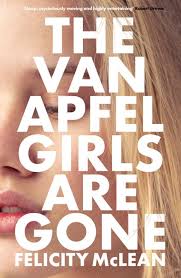The debut novel by Felicity McLean, The Van Apfel Girls are Gone (Harper Collins 2019), is a page-turning mystery written with enough wistfulness and lyricism to satisfy the literary reader and enough suspense and tense plotting to entertain the reader looking for an engaging story.
Tikka Molloy is 11 years old in the long, hot summer of 1992 (one of my children was born during that summer and McLean perfectly captures the unrelenting and oppressive heat). Tikka and her sister Laura are best friends and neighbours with the Van Apfel girls – Hannah, Cordelia and Ruth – who are rather enigmatic, with their evangelical Christian parents and their bible studies and their familial expectations. During the town’s annual Showstopper concert, in which everyone is either performing or in the audience, the three sisters vanish, apparently disappearing into the surrounding bushland. Twenty years later, during a trip home to Australia from the United States, Tikka is assailed by memories of that long-ago summer, the mystery that was never solved and the girls she never forgot. As she spends time with family and old friends, she uncovers new information, but also perhaps finds more questions than answers.
The author cleverly and seamlessly moves between the two time periods. She is a keen observer of details and depicts an adolescent’s perception of that languid summer – the heat, the pool, the insects, the ice-blocks, the boys, the dreams, the fears. Adult Tikka has been shaped by the events of her teenage years, and the disappearance of her friends has left an indelible mark on her psyche. McLean conjures the voices and the attitudes of young girls with wit and authenticity; the dialogue is sharp, the childhood obsessions and passions true, the searching for self-identity and the yearning for adventure are heartfelt and endearing.
This is an easy-to-read book that incorporates the innocent and vulnerable world inhabited by children with the more knowing and experienced – and perhaps disappointed – world of adults. The story is deliciously spare, hinting at details and events without ever providing explanations of exactly what has occurred. This gives the book a whimsical, floaty feeling; a feeling of repressed adolescent angst and of a haunting and unresolved mystery that reverberates through the decades.

